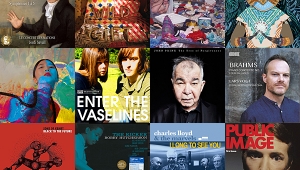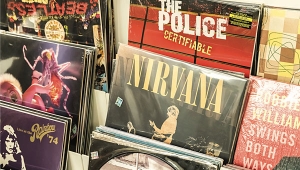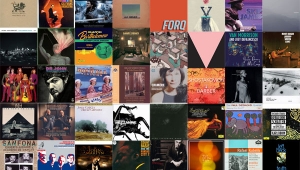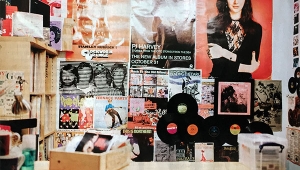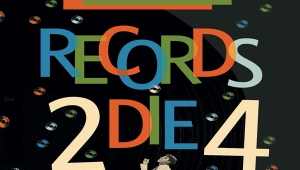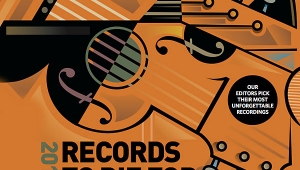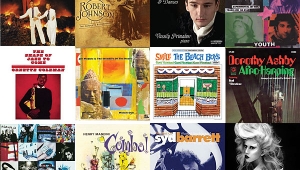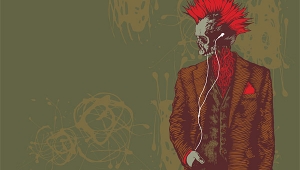| Columns Retired Columns & Blogs |
1996 Records To Die For Page 2
Barry Willis
SCOTT HAMILTON QUARTET: In Concert
Scott Hamilton, tenor sax; Chris Flory, guitar; John Bunch, piano; Phil Flanigan, bass; Chuck Riggs, drums; Eiji Kitamura, clarinet
Concord Jazz CCD-4233 (CD only). Carl E. Jefferson, prod.; Tameo Kawada, Isao Itoh, Phil Edwards, engs. TT: 52:52
Scott Hamilton and crew pump joyous life into nine great old Swing Era standards in this June '83 live recording made in Tokyo's Yamaha Hall. Only 28 at the time, Hamilton was wonderfully out of sync with his contemporaries in mining the rich veins of the past; we are much the richer for his efforts. Lovely arrangements, tremendous ensemble playing, and soaring solos, punctuated by polite, enthusiastic applause in a dry but lively acoustic.
METALLICA: Metallica
Elektra 61113-2 (CD). Bob Rock, James Hetfield, Lars Ulrich, prods.; Randy Staub, Mike Tacci, engs. TT: 62:39
What's this?! Satan's work in Stereophile? Cancel my subscription! Music from the dark side: Metallica's James Hetfield, Lars Ulrich, Kirk Hammett, and Jason Newsted here demonstrate beyond all doubt why they so deservedly rule the heavy metal rockpile, whose peak they claimed without a scrap of radio support. Not daunted by bleak titles like "The Unforgiven," "My Friend of Misery," or "The God that Failed"? Then go ahead, release that deep-seated pain: an unrelenting dose of hate and anger is sometimes the best medicine. Not for the faint of heart.
Stephen Francis Vasta
DEBUSSY: Pelléas et Mélisande
Colette Alliot-Lugaz, Claudine Carlson, Didier Henry, Gilles Cachemaille, Pierre Thau; Montréal Symphony & Chorus, Charles Dutoit
London 430 502-2 (2 CDs only). Ray Minshull, prod.; John Dunkerley, eng. DDD. TT: 2:30:44
Decca/London, which brought out the famous Ansermet/Suisse Romande recordings of Pelléas, has served it even better with its digital entry. Charles Dutoit, in one of his finest recorded outings, limns the music in broad arcs of warm sound without sacrificing limpid clarity of texture, and his conception is sumptuously realized by the Montréal SO. The cast has no weak links; the Mélisande of Alliot-Lugaz and the Golaud of Cachemaille stand out not only for their assured vocalism, but also for their lively, specific, and varied responses to the drama---we may not understand what's going on in this elusive libretto any better, but the performers seem to, and that carries the day. The production team has clothed the whole in luscious yet detailed sonics.
POULENC: Sinfonietta, Aubade
HAHN: Le bal de Béatrice d'Este
Ronald Corp, New London Orchestra
Hyperion CDA66347 (CD only). Arthur Johnson, prod.; Tony Faulkner, eng. DDD. TT: 63:57
The prize here is Reynaldo Hahn's 1909 suite, a charming pastiche of 17th-century dance movements scored for winds, two harps, and piano. The NLO's delightful performance showcases the fluency and finish of some excellent British wind players---the oboes are piquant, the flutes liquid, the horns refulgent. The warm, vibrant instrumental colors of Aubade are appealing (why isn't the excellent piano soloist credited?), while the crisply articulated Sinfonietta uniquely shapes the music in long-breathed lyric lines without shortchanging its bustle and wit. The sound is warm and clear, with good depth.
Michael Ullman
RAY CHARLES: Genius + Soul = Jazz
DCC Compact Classics DZS-038. Creed Taylor, prod.; Steve Hoffman, Terry Howard, digital remastering. ADD. TT: 45:21
Arranged by Quincy Jones and Ralph Burns, this Ray Charles session is special. For one thing, it mostly features Charles as an organist, this time in front of a band consisting mostly of Count Basie's group. The original LP had a full, natural sound with tremendous impact, even if it placed Charles farther back in the group than most vocal albums would. The music is soulful, of course, but also bright and brash in arrangements of "Moanin' " and "Birth of the Blues." My favorites include "One Mint Julep" and the vocal blues: Charles's "I've Got News for You" and his remake of the classic "I'm Gonna Move to the Outskirts of Town." Find the LP (Impulse AS-2) if you can. If not, try this remastering, which captures most of the aura.
ORNETTE COLEMAN: The Shape of Jazz to Come
Ornette Coleman, alto sax; Don Cherry, cornet; Charlie Haden, bass; Billy Higgins, drums
Atlantic 1317-2 (CD). Nesuhi Ertegun, prod.; Bones Howe, eng. ADD. TT: 38:16
I recommend the Atlantic LP over the CD of this groundbreaking, and to some earth-shattering, session. Recorded in 1959, it introduced the Ornette Coleman Quartet to many listeners, some of whom thought he was the future of the music and others who found him a fraud or a joker. What's striking about this and his other Atlantic records is how unimposing and dancelike they sound, how good-humored---one of the great tunes here is "Congeniality." Even the dirge, "Lonely Woman," is in its highly individual way tender. As was common in the late '50s, the engineer has seen fit to radically separate the two horns: Coleman on the left, Don Cherry on the right. Bass and drums are in the far middle, which creates an adequate sense of space. The recording is clear and revealing.
SCOTT HAMILTON QUARTET: In Concert
Scott Hamilton, tenor sax; Chris Flory, guitar; John Bunch, piano; Phil Flanigan, bass; Chuck Riggs, drums; Eiji Kitamura, clarinet
Concord Jazz CCD-4233 (CD only). Carl E. Jefferson, prod.; Tameo Kawada, Isao Itoh, Phil Edwards, engs. TT: 52:52
Scott Hamilton and crew pump joyous life into nine great old Swing Era standards in this June '83 live recording made in Tokyo's Yamaha Hall. Only 28 at the time, Hamilton was wonderfully out of sync with his contemporaries in mining the rich veins of the past; we are much the richer for his efforts. Lovely arrangements, tremendous ensemble playing, and soaring solos, punctuated by polite, enthusiastic applause in a dry but lively acoustic.
METALLICA: Metallica
Elektra 61113-2 (CD). Bob Rock, James Hetfield, Lars Ulrich, prods.; Randy Staub, Mike Tacci, engs. TT: 62:39
What's this?! Satan's work in Stereophile? Cancel my subscription! Music from the dark side: Metallica's James Hetfield, Lars Ulrich, Kirk Hammett, and Jason Newsted here demonstrate beyond all doubt why they so deservedly rule the heavy metal rockpile, whose peak they claimed without a scrap of radio support. Not daunted by bleak titles like "The Unforgiven," "My Friend of Misery," or "The God that Failed"? Then go ahead, release that deep-seated pain: an unrelenting dose of hate and anger is sometimes the best medicine. Not for the faint of heart.
Stephen Francis Vasta
DEBUSSY: Pelléas et Mélisande
Colette Alliot-Lugaz, Claudine Carlson, Didier Henry, Gilles Cachemaille, Pierre Thau; Montréal Symphony & Chorus, Charles Dutoit
London 430 502-2 (2 CDs only). Ray Minshull, prod.; John Dunkerley, eng. DDD. TT: 2:30:44
Decca/London, which brought out the famous Ansermet/Suisse Romande recordings of Pelléas, has served it even better with its digital entry. Charles Dutoit, in one of his finest recorded outings, limns the music in broad arcs of warm sound without sacrificing limpid clarity of texture, and his conception is sumptuously realized by the Montréal SO. The cast has no weak links; the Mélisande of Alliot-Lugaz and the Golaud of Cachemaille stand out not only for their assured vocalism, but also for their lively, specific, and varied responses to the drama---we may not understand what's going on in this elusive libretto any better, but the performers seem to, and that carries the day. The production team has clothed the whole in luscious yet detailed sonics.
POULENC: Sinfonietta, Aubade
HAHN: Le bal de Béatrice d'Este
Ronald Corp, New London Orchestra
Hyperion CDA66347 (CD only). Arthur Johnson, prod.; Tony Faulkner, eng. DDD. TT: 63:57
The prize here is Reynaldo Hahn's 1909 suite, a charming pastiche of 17th-century dance movements scored for winds, two harps, and piano. The NLO's delightful performance showcases the fluency and finish of some excellent British wind players---the oboes are piquant, the flutes liquid, the horns refulgent. The warm, vibrant instrumental colors of Aubade are appealing (why isn't the excellent piano soloist credited?), while the crisply articulated Sinfonietta uniquely shapes the music in long-breathed lyric lines without shortchanging its bustle and wit. The sound is warm and clear, with good depth.
Michael Ullman
RAY CHARLES: Genius + Soul = Jazz
DCC Compact Classics DZS-038. Creed Taylor, prod.; Steve Hoffman, Terry Howard, digital remastering. ADD. TT: 45:21
Arranged by Quincy Jones and Ralph Burns, this Ray Charles session is special. For one thing, it mostly features Charles as an organist, this time in front of a band consisting mostly of Count Basie's group. The original LP had a full, natural sound with tremendous impact, even if it placed Charles farther back in the group than most vocal albums would. The music is soulful, of course, but also bright and brash in arrangements of "Moanin' " and "Birth of the Blues." My favorites include "One Mint Julep" and the vocal blues: Charles's "I've Got News for You" and his remake of the classic "I'm Gonna Move to the Outskirts of Town." Find the LP (Impulse AS-2) if you can. If not, try this remastering, which captures most of the aura.
ORNETTE COLEMAN: The Shape of Jazz to Come
Ornette Coleman, alto sax; Don Cherry, cornet; Charlie Haden, bass; Billy Higgins, drums
Atlantic 1317-2 (CD). Nesuhi Ertegun, prod.; Bones Howe, eng. ADD. TT: 38:16
I recommend the Atlantic LP over the CD of this groundbreaking, and to some earth-shattering, session. Recorded in 1959, it introduced the Ornette Coleman Quartet to many listeners, some of whom thought he was the future of the music and others who found him a fraud or a joker. What's striking about this and his other Atlantic records is how unimposing and dancelike they sound, how good-humored---one of the great tunes here is "Congeniality." Even the dirge, "Lonely Woman," is in its highly individual way tender. As was common in the late '50s, the engineer has seen fit to radically separate the two horns: Coleman on the left, Don Cherry on the right. Bass and drums are in the far middle, which creates an adequate sense of space. The recording is clear and revealing.
- Log in or register to post comments

